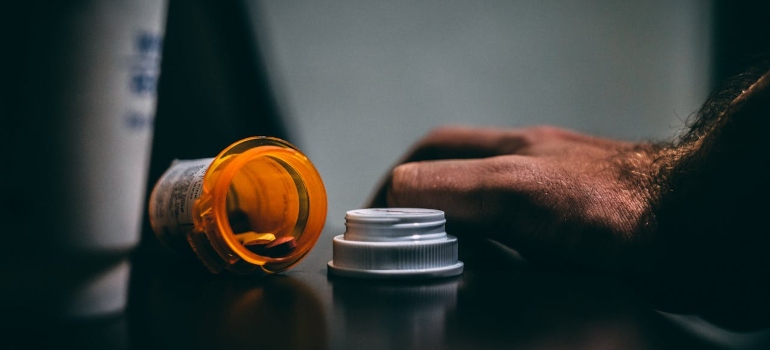Prescription drug abuse has become a growing public health issue that affects individuals, families, and communities. This problem often stems from the misuse of medications prescribed for legitimate reasons but used in unintended ways by healthcare providers. Prescription drug abuse can include taking higher doses than prescribed, using someone else’s medication, or consuming drugs for non-medical purposes. We will explore various strategies to prevent prescription drugs abuse, focusing on education, safe storage, proper disposal, and community support. By implementing these strategies, individuals, families, and communities can reduce the risk of prescription drug abuse and foster healthier, safer environments.
Understanding Prescription Drug Abuse
Prescription drug abuse involves using medication in a manner that differs from the prescribed dosage or intended purpose. This includes drugs like opioids (e.g., oxycodone, hydrocodone), benzodiazepines (e.g., Xanax, Valium), and stimulants (e.g., Adderall, Ritalin). All of these drugs carry a high risk of addiction when misused, leading to dependency, long-term physical and emotional damage, and sometimes fatal outcomes.

According to the National Institute on Drug Abuse (NIDA), approximately 18 million people in the U.S. have misused prescription drugs at least once in the past year. This statistic highlights the importance of prevention, awareness, and education efforts to deal with the widespread misuse of these medications. In 2019 alone, the misuse of prescription opioids contributed to over 70,000 overdose deaths in the U.S., emphasizing the urgent need for strategies aimed at curbing this issue. Prescription drug abuse can lead to addiction, overdose, and severe emotional and physical health problems.
7 Strategies to Prevent Prescription Drugs Abuse
Preventing prescription drug abuse requires a multi-faceted approach that involves individuals, healthcare providers, families, and communities. Below are seven effective strategies to address this issue.
- Education and awareness
- Safe storage practices
- Proper disposal of unused medications
- Monitoring and communication with healthcare providers
- Creating a supportive environment
- Utilizing technology for monitoring
- Alternative pain management solutions
Education and Awareness
One of the most powerful strategies to prevent prescription drugs abuse is through education and awareness. Educating patients about the risks of misusing medications can reduce the likelihood of abuse. Healthcare providers must take an active role by thoroughly explaining the dangers of prescription medications. They should also encourage responsible use and monitor patients closely, especially those at higher risk of addiction.
Public awareness campaigns are equally important. These campaigns can educate the general public on the risks and consequences of misuse, including addiction, overdose, and death. Schools, workplaces, and community centers serve as ideal locations to spread information on safe medication use and how to avoid misuse. Families should also be informed, so they can spot early warning signs of potential abuse and intervene when necessary.
Healthcare providers also need ongoing education and training on safe prescribing practices. This includes understanding the potential for abuse when prescribing medications like opioids and keeping up with the latest monitoring techniques. Through these education efforts, we can create an informed society that actively works to prevent prescription drug abuse before it begins.
Safe Storage Practices
Properly storing medications is important for keeping them out of the hands of those who may misuse them, especially children and teenagers. Safe storage should include keeping medications in a lockable storage container and storing them out of sight. By taking these precautions, people can significantly reduce the risk of unauthorized access to prescription drugs. Safe storage is often overlooked but can be very beneficial in reducing unintentional misuse by family members or friends. Key safe storage tips include:
- Store medications in a locked cabinet or container
- Keep prescription drugs out of children’s sight and reach
- Avoid sharing medications with others

Educating families on safe storage practices is a simple yet effective way to prevent prescription drug abuse. It is necessary to remind people that keeping medications in secure locations helps reduce the likelihood that curious children or teens might access them and misuse them, either intentionally or accidentally.
Proper Disposal of Unused Medications
Disposing of unused or expired medications properly is another important strategy for preventing misuse. Many people do not realize that keeping unused medications in their homes increases the risk of abuse. Drug take-back programs offer an effective way to safely dispose of medications. These programs are available in many communities and pharmacies, providing a safe and environmentally friendly way to discard potentially dangerous substances.
Improper disposal, such as flushing medications down the toilet, can harm the environment and pose a risk to water supplies. Always follow local guidelines for disposing of medications safely. Many areas have designated disposal sites where individuals can drop off unused drugs. Participating in these programs can reduce the number of unused medications in circulation, lowering the risk of accidental misuse or intentional abuse.
For people managing a large number of prescriptions, using tools that track when medications are no longer needed can help prevent excess storage of drugs. Furthermore, participating in local drug take-back days is a way to ensure these medications are safely removed from the home and out of reach of those who might misuse them.
Monitoring and Communication with Healthcare Providers
Open communication with healthcare providers is necessary for preventing prescription drug abuse. Patients must be encouraged to discuss any concerns or side effects related to their medications. Healthcare providers, in turn, should monitor patient use closely, particularly for medications with a high potential for abuse. Patients and providers need to work together to ensure that medications are used responsibly and only for their intended purpose.
Healthcare providers can implement prescription drug monitoring programs (PDMPs) to track prescriptions and prevent misuse. PDMPs allow providers to identify potential patterns of misuse early, ensuring that any issues are addressed before they escalate. Additionally, patients should be regularly followed up with to ensure they are adhering to their prescribed treatment plans.

Providers should also educate their patients about the importance of individual therapy for addiction if they notice signs of dependency. This way, patients have a clear path toward addressing their concerns without resorting to misuse or avoidance. Regular check-ins and medication management plans provide a structured way to prevent misuse and encourage safe medication practices.
Creating a Supportive Environment
Family and friends play the most important role in preventing prescription drug abuse. Being vigilant about the signs of misuse and creating a supportive environment can help deter someone from abusing prescription drugs. Open dialogue about substance use is key to maintaining transparency and providing a space where people feel comfortable seeking help.
Family therapy for addiction is an important resource for families struggling with substance abuse. Therapy can provide a safe environment for discussing concerns, building trust, and offering support for those at risk. Furthermore, rehabs in WV offer local resources for families seeking more intensive interventions to help their loved ones. Creating a culture of open communication and support can help prevent prescription drug misuse before it begins.
The role of friends and community members cannot be underestimated either. Regular conversations and check-ins can make a significant difference in someone’s decision to seek help for misuse. Additionally, support groups and community outreach can create a more compassionate, understanding environment for those struggling with or at risk of addiction.
Utilizing Technology for Monitoring
Technology can be a valuable tool in preventing prescription drug abuse. Numerous apps and online tools help people keep track of their medication schedules, sending reminders to take their medication on time and monitor overall use. These digital tools can prevent accidental misuse by keeping users on a responsible schedule.
Healthcare providers can also use technology to monitor patient adherence to their medication plans. Digital systems allow providers to track usage and detect signs of misuse early, making it easier to intervene. Patients can receive alerts if they deviate from their prescribed regimen, ensuring they stay on track.
By combining technology with regular communication between patients and healthcare providers, patients are better equipped to manage their medications safely and effectively. This is particularly beneficial for those managing long-term prescriptions, as it provides an extra layer of accountability and support.

Alternative Pain Management Solutions
While prescription medications like opioids are often used to manage pain, non-pharmacological approaches can offer safer alternatives. Holistic therapy for addiction, physical therapy, acupuncture, and mindfulness practices are a few examples of treatments that can reduce reliance on prescription drugs. These alternatives not only address the physical aspects of pain but also help manage the emotional and mental health components.
Before prescribing medications, healthcare providers should explore alternative treatments with their patients. Offering a range of treatments can reduce the chances of developing a dependency on prescription drugs and encourage healthier, long-term management strategies. This strategy not only helps people avoid addiction but also promotes a more holistic approach to well-being.
Exploring alternatives like acupuncture and mindfulness early on can make a significant difference in reducing the need for prescription drugs and preventing the cycle of misuse. Physical therapy can also help manage chronic pain without relying on medications, offering a more sustainable solution to long-term pain management.
Risk Factors and Early Intervention
Certain risk factors increase the likelihood of prescription drug abuse. Recognizing these risk factors early can help prevent misuse before it starts. For instance, people with untreated mental health issues may turn to prescription drugs as a form of self-medication, increasing the risk of misuse. Additionally, environments where drug use is normalized, such as certain social circles or family situations, can further contribute to the likelihood of abuse. These factors include
- History of substance use
- Mental health disorders
- Peer pressure
- Easy access to medications
Intervention strategies such as individual therapy for addiction and counseling can be highly effective in dealing with these risks. Early intervention programs help people understand how drugs alter the emotional state and offer healthier coping mechanisms. Addressing these emotional and mental health challenges through counseling can significantly lower the chances of dependency on prescription medications.

Support groups, counseling, and drug rehab for young adults offer beneficial resources for people facing these risks. The sooner these risk factors are identified and addressed, the more likely it is that individuals will avoid long-term issues with prescription drugs.
Community Resources and Support
Community resources are important for prevention. Local health programs, hotlines, and counseling services can offer assistance to people struggling with prescription drug misuse. Many communities also offer educational programs that focus on awareness and prevention, teaching residents about the dangers of prescription drug abuse. These resources are necessary not only for those at risk but also for families seeking guidance on how to help loved ones avoid addiction.
Programs like rehabs in WV and drug rehab for young adults are crucial for people seeking recovery. Access to these programs can make a significant difference in early intervention and long-term recovery outcomes.

Encouraging social connections in addiction recovery also helps those at risk stay on the path to recovery and prevent relapse. Building a network of supportive peers and mentors creates a sense of accountability and encourages individuals to remain committed to their recovery journey. These support systems provide emotional and mental support to individuals as they navigate their recovery process.
Legislation and Policy Advocacy
Policies and legislation are important for preventing prescription drug abuse. PDMPs help healthcare providers monitor prescriptions and prevent doctor shopping, but more comprehensive legislation is often needed to ensure medications are prescribed safely. Laws that require healthcare providers to undergo mandatory training on prescribing high-risk medications, such as opioids, can help reduce the frequency of over-prescribing. Additionally, stronger penalties for illegal distribution and misuse of prescription drugs can act as a deterrent for potential abusers.
Regulations surrounding prescribing practices ensure medications are only prescribed when necessary and in safe amounts. Limits on prescription durations, as well as requiring thorough patient assessments before prescribing, can help prevent misuse from the start. Advocating for policies that promote safe prescribing and increased access to treatment resources is necessary for long-term prevention efforts. Community members and healthcare professionals should work with lawmakers to ensure public health remains a priority when it comes to prescribing medications.
Building a Safer Future: Implementing Strategies to Prevent Prescription Drugs Abuse
Prescription drug abuse is a complex issue, but with the right strategies, it can be prevented. Strategies to prevent prescription drugs abuse include education, safe storage, proper disposal, and open communication with healthcare providers. Early intervention, family support, community resources, and professional help are equally important in preventing abuse. By taking these proactive steps, we can reduce the prevalence of prescription drug misuse and create healthier, safer communities.
References:
https://nida.nih.gov/sites/default/files/2609-misuse-of-prescription-drugs.pdf
https://www.naccho.org/programs/community-health/injury-and-violence/overdose/health-equity-drug-overdose-response



